Do You Like Mary Matalin’s Facelift?
Renowned political consultant, Mary Matalin, is 62. Here, we show her pre-and-post facelift. Tell us whether you think Mary is a good or bad poster girl for facelifts.


Renowned political consultant, Mary Matalin, is 62. Here, we show her pre-and-post facelift. Tell us whether you think Mary is a good or bad poster girl for facelifts.

We are continually hearing about new invasive and non-invasive plastic surgery techniques for removing fat from our bodies, but how do you know which one is right for you? Or, if you’re even a candidate for any of them?
 Dr. Siamak Agha is one of the country’s most respected authorities in body contouring and post-bariatric plastic surgery. His leading-edge innovations have been remarkable, including development of the revolutionary Body Lift, Abdominoplasty™, Spiral Thigh Lift, and Buttock Reshaping procedures. Dr. Agha has published numerous papers and multiple textbook chapters on basic science, stem cells, aesthetic plastic surgery, and body contouring techniques. Dr. Agha is also a researcher in the field of Molecular and Cell Biology and has a PhD in Gene therapy for University of Cambridge.
Dr. Siamak Agha is one of the country’s most respected authorities in body contouring and post-bariatric plastic surgery. His leading-edge innovations have been remarkable, including development of the revolutionary Body Lift, Abdominoplasty™, Spiral Thigh Lift, and Buttock Reshaping procedures. Dr. Agha has published numerous papers and multiple textbook chapters on basic science, stem cells, aesthetic plastic surgery, and body contouring techniques. Dr. Agha is also a researcher in the field of Molecular and Cell Biology and has a PhD in Gene therapy for University of Cambridge.
I recently had an illuminating conversation with Dr. Agha about plastic surgery and weight loss. Although I live in New York, I’d happily fly across the country to have him work on my body.
![]()
![]()
WHAT ARE THE RULES CONCERNING THE WEIGHTS AT WHICH PATIENTS SHOULD OR CAN HAVE PLASTIC SURGERY?
Let’s say you’re a little overweight, maybe 10 to 15 pounds, and want to have a tummy tuck. Most plastic surgeons will say, ‘OK, go on and lose 20 pounds. Then come back for the procedure.’ My philosophies are a little different. I feel that procedures shouldn’t be done at specific weights, but at the weights at which a person is stable for a long period. Why? If your body functions best with the extra 10 to 15 pounds, you’re better off having the surgery at the higher weight, than struggling to lose it, having the procedure, and ultimately gaining back the 15 pounds, which will affect the results.
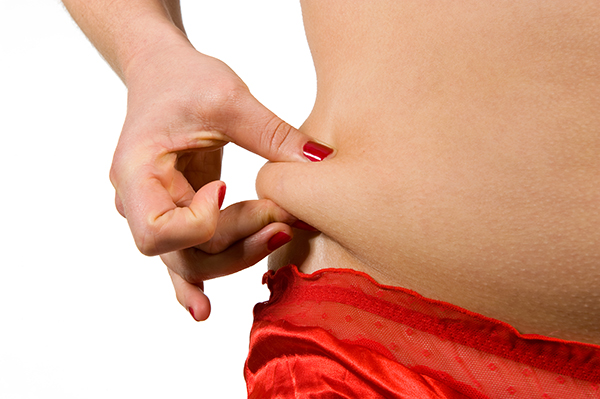
Have the procedure at the higher weight. I’ll contour your body for the best outcome for that weight. Let’s say you’re having a tummy tuck, but your flanks are bigger. I’ll do the tummy tuck, as well as lipo on the flanks. That way, you look your best at the weight that you are stable in. If you happen to lose weight after the surgery, that’s okay. In that case, you might develop some skin laxity, and may need just a small touchup to optimize the procedure.
WHAT IF SOMEONE IS STRUGGLING TO LOSE 30 OR MORE POUNDS? SHOULD SHE HAVE PLASTIC SURGERY?
 In cases like this, patients really have to lose the excess weight, which can be done in one of three ways:
In cases like this, patients really have to lose the excess weight, which can be done in one of three ways:
•Proper diet and exercise
•Medical weight loss: A number of new medications have recently been FDA approved (more on this in another interview with Dr. Agha) for medical weight loss
•Weight-loss surgery
Up until now, it was a rather cumbersome and costly procedure if you had to lose 80 or 200 pounds. But recently the FDA has approved use of a gastric balloon, a temporary device that is placed in your stomach for about 6 months to help you lose 40 pounds. It has been used in Europe, Canada and Australia for the last decade, so we know who makes the optimal patient.
WHAT IS THIS BALLOON TECHNIQUE CALLED AND HOW DOES IT WORK?
It’s called Orbera, which fills your stomach with about 600 milliliters of fluid. Think of it like a breast implant that is sitting in your stomach all the time. When you eat you become full quicker. The balloon also slows down gastric emptying so the food sits in the stomach for a longer period and you’re full longer.
The procedure gives you the satiety which will help you to lose weight, but you must use the six months to learn how to change your lifestyle so that you don’t quickly gain the weight back when the balloon is removed. Patients need to be brought back to the office on regular basis to be coached by a dietician and given the tools to change their lifestyles.
The procedure is not dangerous if you’re healthy and in shape.
WHEN YOU GAIN WEIGHT AFTER BODY CONTOURING PROCEDURES, SUCH AS LIPOSUCTION, WHERE DOES THE WEIGHT GO?
Fat cells store fat and you have a fixed number of these cells in your body. Let’s say it’s 100. They don’t multiply or reproduce unless there’s a significant injury, and even in those cases, only a small percentage will reproduce to become fat cells.
So, let’s say we remove half of the abdominal fat cells. Since this is a permanent reduction of fat cells from your abdomen, the remaining fat cells still will expand if you gain weight, but the fat cells in other areas of your body (that haven’t been touched) will also expand and they are greater in number. So fat that normally might go to your abdomen might go to your midriff area, arms or legs since the number of fat cells in those areas are unaltered.
WHAT HAPPENS WITH THE FAT CELLS AFTER FAT TRANSFER?
When you transfer fat cells from one area of your body to another (let’s say to the butt or breasts), they become a permanent part of the fat cell environment in the new region. So, if you gain weight, and you had fat transfer to the butt, it will become even bigger.

![]()
WHEN WE DIET, WHAT DETERMINES WHERE WE’LL LOSE WEIGHT AND AT WHAT RATE?
Your fat cell distribution is genetically predisposed, which means you may have 100 fat cells in your thighs and five in your face. When you’re a lean person, all of these cells are tiny and empty. When you gain weight, each area gains weight according to the number of fat cells it contains, and how these cells act, so if your face has fewer fat cells, the weight won’t show as much.
Fat cells in different areas of the body may actually have different genetics, metabolism rates, and storage capabilities, but we haven’t done enough research in this area to know conclusively.
WHAT IS SOMEONE DIETS TO LOSE 80 POUNDS, HAS BODY CONTOURING, AND THEN GAINS BACK MOST OF THE WEIGHT?
Shame on them!
WHAT TYPES OF PROCEDURES ARE YOUR PATIENTS HAVING?
The body is the new face. A woman will fix up her face, and then say it doesn’t match her body. She’s not comfortable in her body.
I do body lifts on women of normal weight, who have lost their contours as a result of skin laxity from aging, and don’t feel comfortable in their skin anyone. Cultural may play a part. In Brazil, for example, it’s far more common to do body procedures than in the United States because Brazilians show more skin.
•Divorce: Half of the boomer population is divorced. If a 55-year-old woman divorces, and wants to date, she wants to present herself in her ideal shape.
•Sex: Older people are enjoying sex and they want their bodies to look the best they can.
PLEASE TELL US ABOUT THE INVASIVE AND NON-INVASIVE PROCEDURES THAT RELATE TO BODY CONTOURING
Skin laxity (from weight loss or aging) gives you the wrinkles, body contour irregularities, and more. And skin damage, combined with excess fat globules, produce cellulite. My practice is busy because I do procedures to remove the lax skin and sculpt at the same time, making sure incisions are located in the right places.
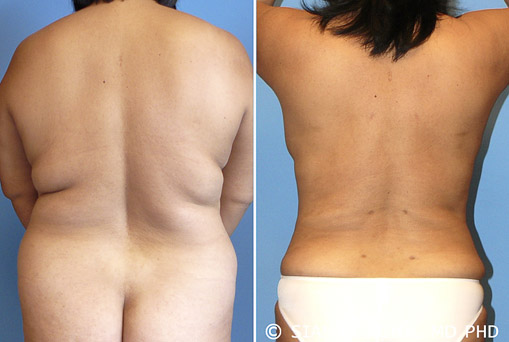

We do tummy tucks; tummy tucks together with breast lifts; thigh lifts; buttock lifts; liposuction; fat transfer to the buttocks and breasts. Currently, there are no modalities (such as lasers, radio frequency, freezing) to give you acceptable skin reductions and contractions.
There’s a huge market for non-invasive fat reduction procedures, but these aren’t substitutes for liposuction or weight loss. They’re contouring or sculpting treatments.
 I bought the Coolsculpting machine for my Newport Beach mothers who have the tiniest bit of fat. The procedure gives them 35% fat reduction and makes them happy. The most important thing to me is that it works. We’ve been doing Coolsculpting for four years and patients are satisfied.
I bought the Coolsculpting machine for my Newport Beach mothers who have the tiniest bit of fat. The procedure gives them 35% fat reduction and makes them happy. The most important thing to me is that it works. We’ve been doing Coolsculpting for four years and patients are satisfied.
The procedure has to be targeted to one area at a time, such as your lower or upper abdomen, for example, or your flanks.
Ultrashape uses focused ultrasound energy to break fat cells and damage them permanently. The damaged fat cells are then removed by your own white cells, and excreted from your body. Similar to CoolSculpting, the fat is permanently reduced in the treated area.
Vanquish Fat Removal is a radio frequency device that reportedly provides 1 to 13 centimeters of reduction of the waist measurement by destroying the fat cells underneath the skin. Four treatments are recommended. I need to do more research on this, before I decide whether to use it in my practice.
A procedure called SculptSure is hitting the market next year. It is a laser designed to break the fat underneath the skin.
Many new devices are being marketed, that are covering more and more areas of the body, but we won’t see if patients and doctors are happy with them for a few years. I want to make certain that a device sells itself before using it. The literature must says it works; my colleagues must say it works; the science must say it works.
Visit Dr. Agha’s website to learn more about his brilliant work.
FabOverFifty is delighted to announce that we’ve formed a partnership with Francesca Camp, a leading independent plastic and cosmetic surgery consultant, in the US and abroad, who is becoming our plastic surgery guru. Francesca will be writing a monthly column and can answer many of your questions about invasive and non-invasive procedures. Of course, we’ll still have our valuable Ask A Plastic Surgeon Tool, but Francesca can provide an additional viewpoint, as someone who has worked with thousands of women who’ve had surgery, or are considering it.
“If you’re like nine out of ten of my clients, the first question on your mind is not what kind of surgery you need or who should perform it but something much more basic: ‘Do I need it?’” which happens to be the title of Francesca’s new book.
“In fact there are times when I tell people that they don’t. I’m an independent practitioner, and I’m not on anyone’s payroll. I don’t get compensated for referrals, so I don’t stand to gain or lose by recommending any services. My professional role is to offer advice to people who are unhappy about their appearance and don’t know what to do and where to start. Not all the solutions I offer involve surgery,” she explains in the very first chapter.
![]()
Meet Francesca!
![]()
When Francesca Camp was in her 20s, long before anyone but movie stars and Park Avenue matrons had “work done,” she had a complete surgical makeover on her young, pretty face. It wasn’t by choice, however. A five-car accident left Francesca with a fractured nose, shattered, left cheekbone and lacerations, and she needed to find a competent plastic surgeon to reshape her disfigured face.
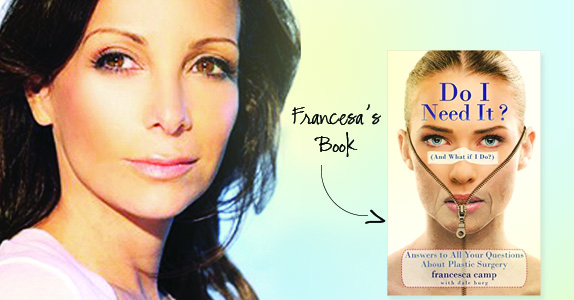
Before the accident, Francesca had worked with burn patients in Chile and, as a graduate student, with inner city and battered and abused women, experiences that taught her the psychological importance of feeling “good about your appearance.” Forced to wait a year for her face to fully heal, before she could get the plastic surgery to fix it, Francesca learned even more, first hand, about compassion and empathy. She says she has two sides: “Mother Teresa and the vanity side.”
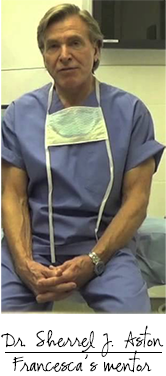 Although it wasn’t a pretty–or voluntary–way to get involved with plastic surgery, that fateful accident led her to be treated by, and then work for, Dr. Sherrell Aston, one of the New York’s leading plastic surgeons. Francesca also earned a license as a paramedical esthetician. During the six years she was Dr. Aston’s employee, she became the one who answered all his patients’ questions. She learned what people want and need to know. A good resource for information, Francesca also gave patients reassurance and confidence.
Although it wasn’t a pretty–or voluntary–way to get involved with plastic surgery, that fateful accident led her to be treated by, and then work for, Dr. Sherrell Aston, one of the New York’s leading plastic surgeons. Francesca also earned a license as a paramedical esthetician. During the six years she was Dr. Aston’s employee, she became the one who answered all his patients’ questions. She learned what people want and need to know. A good resource for information, Francesca also gave patients reassurance and confidence.
Encouraged by the excellent response to her skin care and counseling services, Francesca eventually decided to open her own practice, and she’s been a independent plastic/cosmetic surgery consultant for almost 20 years. “Because of my professional connections to the world’s leading plastic and cosmetic surgeons and my ability to know what to look for and what to research, I am able to refer people to doctors anywhere who specialize in the areas of their concern, who have the right credentials, and who will perform the proper procedures with competence,” Francesca explains in her new book, Do I Need It? (And What if I Do?) Answers to All Your Questions About Plastic Surgery, with Dale Burg
“This really is a rule book, a hand-holding guide for the entire process,” Francesca told me when we met for coffee and an interview. “I used to write the pre- and post-op instructions for plastic surgeons, and the book provides the answers to all the questions that patients asked.” Besides answering the paramount question, “Do I Need Plastic Surgery?” these are among the questions answered in the book:

“When I recommended to a CEO client, who ran a big corporation, that she not do something she was considering, post-surgery, she took my face in her hands and said to me: ‘When it comes to this, I have no common sense,’” Francesca said, demonstrating that even women who make high-level decisions all day long need guidance when it comes to their looks.
Written in simple language, with a reassuring attitude and a touch of humor ( “A really good doctor makes you look like yourself, only better. He or she can’t turn back the clock and make you look twenty-five–unless you’re thirty!”), the book makes the plastic surgery process less intimidating and offers practical advice you won’t find anywhere else. Francesca even covers the type of bedding to use for your recuperation!
During our chat, Francesca answered a few of my own questions. Read what she had to say.
![]()
![]()
Why do you think that plastic surgery naysayers are so vocal?
Many women think they’ve ‘earned’ their wrinkles or stretch marks, and they become judgmental. But I say, ‘never say never. You’re getting your hair colored, you’re getting your nails done, you’re putting on makeup, and you’re working out at the gym. Plastic surgery is another way for you to be a better you.’
Ninety-eight percent of my patients don’t want to look 20. They want to look like themselves, but just a little bit better.
Where do you work and do you get a referral fee from the doctors you recommend?
I have offices in LA; New York; Naples, Florida, and Vienna, Austria, where I’m in a wonderful new clinic, but still independent from the doctors who practice there. I get no kickbacks or referral fees. I don’t personally know every single surgeon I recommend, but my connections, and researching experience, always lead me to the best doctors for my patients.
I lecture at medical symposiums, and I’ve collected great doctors along the way. I’ve been in the OR observing surgery. I have to see what my patients are going through so I can help them heal. My client list is like a who’s who. They come to see me from around the world.
If a woman is on the fence about having plastic surgery, how can you convince her to at least have a consult?
 You really have to listen and find out why someone is on the fence. People still are afraid. So I listen carefully to hear why they’re afraid.
You really have to listen and find out why someone is on the fence. People still are afraid. So I listen carefully to hear why they’re afraid.
Those I call my ‘merry-go-round patients’ have been to see seven doctors, which is always a red flag. I’d rather have someone who has questions and knows what she wants. Women open up more to me than to surgeons. Surgeons actually refer women to me, before consulting with them.
What trends are you seeing today in terms of procedures?
1. More women are getting non-invasive treatments, but it’s becoming a double-edge sword. I’m seeing bad fillers that result in squinty eyes and over-filled cheeks. If you don’t have a line on your face, it looks freaky to me. Mothers and daughters are starting to look like each other. You have to leave a couple of wrinkles to look natural. Less is definitely more, even with fillers. Sometimes, only the knife is going to do the trick, but you also have to eat right, drink enough, and exercise.
2. Chemical or laser peels are great, but you must make sure a qualified doctor does it.
3. A new filler, Juvederm Voluma XC, is getting good results. It’s doing a nice job on the lips.
4. Many women will tell me what a cousin’s friend had done, for example, and who did it, and will decide on which plastic surgeon to use based on word of mouth. I make my decisions based on the volume a surgeon does. If a doctor is doing 600 of a certain procedure a year, he generally knows what he’s doing.
5. More women over 50 are having the tips of their noses refined. The eyes and nose make the greatest difference in your looks.
6. I am against doctors who aggressively promote before-and-after-photos, which is becoming more and more prevalent.
How do younger surgeons today differ from ‘old-school’ men in their 60s, let’s say?
You don’t hit your stride as a plastic surgeon until your late 40s. Plastic surgery has changed dramatically in the last 15 years, and the new boys (under 50) are learning the new techniques. Healing time is quicker; scars are shorter; there are fewer invasive techniques, and doctors are using lasers and injections with surgery.
Are the older doctors keeping up with the changes and should you avoid a doctor older than 60?
If you were a great doctor in your time, you’ll be a great doctor now, but only if you’re willing to keep up with the new techniques. I’ve also seen young doctors who aren’t up on techniques.
Plastic surgery symposiums are so important because they promote everyone working together and passing knowledge on to the next generation.
Do women plastic surgeons relate better to women patients?

Yes, they do. I’m now seeing more and more females go into the field, especially in Brazil, which is refreshing. The American and Brazilian Plastic Surgery Societies are now running meetings together, as a matter of fact, and American doctors will go to Brazil for their residencies, where plastic surgery is a craft. Brazilians use very sophisticated techniques, and it’s not frowned on to have plastic surgery there. Patients also are more willing to travel there.
What do you think of websites that promote patient reviews and compare doctor fees for the same procedures?
It’s hard for a layperson to decipher what’s best, what’s true, and what’s not true, so I’m against sites like that. Choosing a plastic surgeon is like choosing a car or a name for your child. No matter what car you say you’re going to buy, or name you choose, someone will ask: ‘Why are you buying THAT car or choosing THAT name? This also isn’t the time for a Kmart special. Just because you put something on a website doesn’t make it true. There’s too much out there on the Internet; it’s too confusing, and many women will decide ‘‘I’ll do it next year,’ rather than do the proper vetting.

What do you say to the fact that cost is one of the biggest obstacles to having plastic surgery?
One client started a “Plastic Surgery Fund” when she stopped smoking. All the money she saved on cigarettes went into the fund. I love that idea.

This is a “sponsored post.” LightStream compensated FOF with an advertising
sponsorship to write it, and provides more information at LightStream.com. Regardless,
I only recommend products or services I believe will be helpful for our readers.
All insights and expressed opinions are my own. —Geri Brin
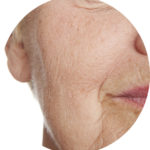 Ever since Hannah noticed the first sign of jowls on her face, she’s been thinking of having plastic surgery to get rid of them. She’s vowed for years that she would “grow old gracefully,” and never let a scalpel get near her, but she really hates those jowls and wants to see them go. They’re definitely not “graceful.”
Ever since Hannah noticed the first sign of jowls on her face, she’s been thinking of having plastic surgery to get rid of them. She’s vowed for years that she would “grow old gracefully,” and never let a scalpel get near her, but she really hates those jowls and wants to see them go. They’re definitely not “graceful.”
The American Society of Plastic Surgeons
(ASPS) reported that the number of minimally invasive cosmetic procedures performed in 2014 increased 4% from 2013, and a whopping 154% from 2000.
Here are the most popular.

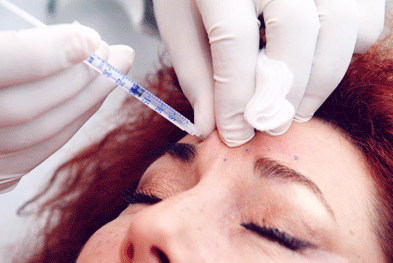
Under the brand names Botox, Xeomin, and Dysport, this toxin is injected into areas of the face to block muscular nerve signals and weaken muscles so they can’t contract. As a result, you’ll see a reduction of wrinkles and smoother skin. Common sites for this injection are the Crow’s feet around the eyes and frown lines on the forehead.
*Number of anatomic sites injected
The stigma of plastic surgery is no longer
an issue for most women; if anything, a well-done
nip/tuck is something to be proud of, and shared
with girlfriends.
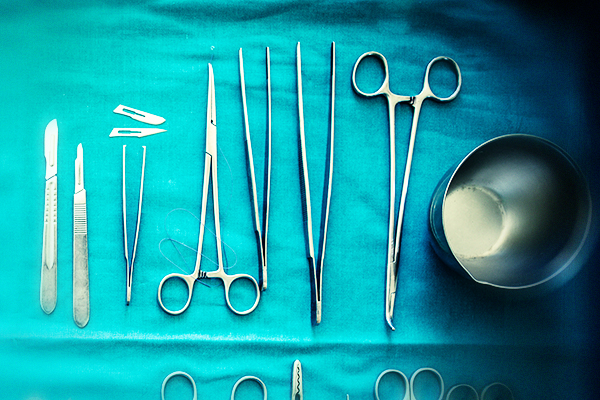
It’s also no secret that advances in medicine mean that cosmetic procedures are safer, more efficient, and more effective than ever. Despite these facts, however, five reasons stop many fab women over 50 from moving ahead and booking appointments for aesthetic procedures they’d love to have.
As one of Houston’s busiest cosmetic surgeons, I have some good news: These challenges shouldn’t be enough to keep you away from having your dream cosmetic treatment.
Challenge # 1: MONEY

No matter who you are, the cost of plastic surgery will always be a concern. Even though health insurance rarely covers these elective procedures, cosmetic treatments are becoming increasingly affordable on any budget. The most respected cosmetic surgeons also offer several financing options. This can help to get your desired procedure today—when you really want it—without saving for months or draining your bank account.
This post is sponsored by Syneron-Candela, the makers of UltraShape.
Have you been battling a “muffin top” the last few years that you just can’t eliminate or reduce, no matter how much you exercise or how wisely you eat?
A new non-invasive treatment that’s quick and painless, could help you whittle your middle.

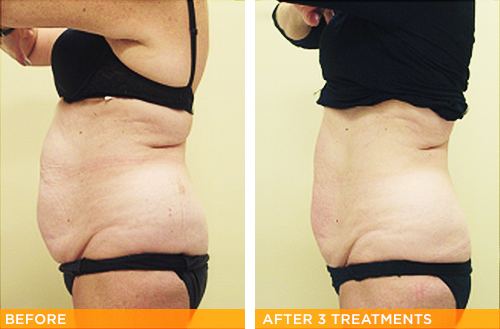
Unlike other fat-reduction treatments that reduce fat using heat or freezing technologies, FDA-cleared UltraShape uses painless pulsed ultrasound waves to break the fragile walls of fat cells below the skin, which then allows the body to eliminate the fat through natural processes. UltraShape’s gentle focused UltraSound destroys those fat cells while keeping surrounding tissue, muscle, nerves and blood vessels intact.
What’s more, the treatment doesn’t require anesthetics and or leave lumps, bumps or bruises like other fat reduction treatments do.

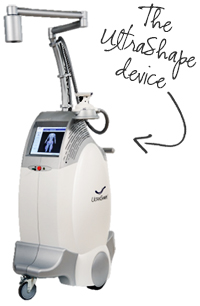
UltraShape can target specific trouble spots in the abdominal area, such as love handles or that little tummy bulge, and it destroys fat cells immediately. Results are smooth without lumps or uneven areas of the skin.
A slimmed-down look can be achieved in as little as two weeks, significantly faster than other fat-reduction technologies. UltraShape generates an average fat reduction of up to 2.5 inches.
The full procedure requires three 45-minute sessions, spaced two weeks apart. They even can be done on your lunch break, since there’s no downtime.
In case you haven’t heard the great news, you can effectively lift your sagging facial and
neck skin, without surgery!
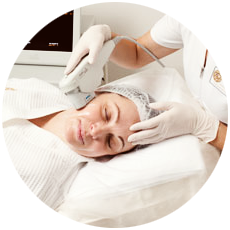
Ultherapy, a non-invasive cosmetic procedure, uses ultrasound technology to direct heat to the underlying layers of your skin. This technique “lifts, tightens, and tones,” says Dr. Kevin Tehrani, a New York board-certified plastic surgeon. The treated areas heal as your body stimulates collagen production, creating a tightening effect. Not only is Ultherapy designed to improve the chin, brow and neck areas; it’s now FDA-cleared to work on décolletage wrinkles, too!
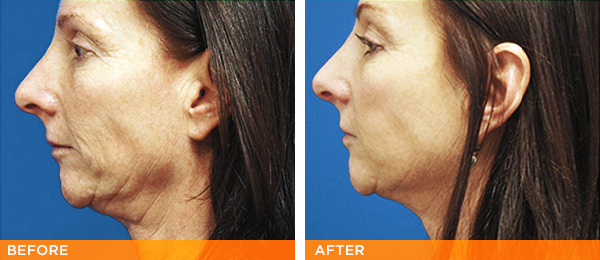
An Ultherapy procedure performed by Dr. Kevin Tehrani
Ulthera, Inc., the creator of Ultherapy, is giving away an Ultherapy treatment. Simply visit the entry page and follow the instructions. You’ll also be able to see a simulation of what Ultherapy would look like on you!
Click on the image below to enter!

This post is sponsored by Ulthera, Inc. Thank you for supporting FabOverFifty!